AD 2 Aerodromes
OTBD — DOHA INTL
OTBD AD 2.1 AERODROME LOCATION INDICATOR AND NAME
OTBD — DOHA INTL
OTBD AD 2.2 AERODROME GEOGRAPHICAL AND ADMINISTRATIVE DATA
| 1 | ARP coordinates and site at AD | 251539.81N 0513354.34E, Mid - point of RWY, on CL. | |||
| 2 | Direction and distance from (city) | 3.5 NM SE from Doha City Centre | |||
| 3 | Elevation/Reference temperature | 37 FT / 41 | |||
| 4 | Geoid undulation at AD ELEV PSN | -98 FT | |||
| 5 | MAG VAR/Annual change | 2.6˚E (FEB 2020) / 0.03˚E | |||
| 6 | AD Operator, address, telephone, telefax, telex, AFS and website address | AD Operator: | Qatar Company for Airports Operation and Management - MATAR | ||
| Address: | Chief Operating Officer Hamad International Airport P.O. Box 24730 Doha State of Qatar | ||||
| Tel: | (974) 4010 7715 / (974) 4010 3999 | ||||
| Fax: | (974) 4010 1010 | ||||
| Email: | coohiaoffice@hamadairport.com.qa | ||||
| Website: | www.dohahamadairport.com | ||||
| SITA: | DOHAOXH | ||||
| 7 | Types of traffic permitted (IFR/VFR) | IFR / VFR | |||
| 8 | Remarks | Airport Operations Control Centre Duty Manager (AOCC DM) 24/7:
| |||
OTBD AD 2.3 OPERATIONAL HOURS
| 1 | AD Operator | H24 |
| 2 | Customs and immigration | H24 |
| 3 | Health and sanitation | H24 |
| 4 | AIS Briefing Office | H24 |
| 5 | ATS Reporting Office (ARO) | H24 |
| 6 | MET Briefing Office | H24 |
| 7 | ATS | H24 |
| 8 | Fuelling | On prior notification to fuel provider. See Item 10 of GEN 1.1 |
| 9 | Handling | On prior notification to ground handler. See Item 9 of GEN1.1 |
| 10 | Security | H24 |
| 11 | De-icing | Not required due to local climate |
| 12 | Remarks | NIL |
OTBD AD 2.4 HANDLING SERVICES AND FACILITIES
| 1 | Cargo-handling facilities | Available. (Qatar Aviation Services) |
| 2 | Fuel/oil types | Fuel: Jet A1 AVGAS 100 available at Qatar Aeronautical Academy (QAA). Oil: NIL. |
| 3 | Fuelling facilities/capacity | On prior notification. See Item 10 of GEN 1.1 |
| 4 | De-icing facilities | Not required due to local climate. |
| 5 | Hangar space for visiting aircraft | NIL |
| 6 | Repair facilities for visiting aircraft | Contact QAS, see Item 9 of GEN 1.1 |
| 7 | Remarks | For handling facilities / services contact QAS, see Item 9 of GEN1.1 |
OTBD AD 2.5 PASSENGER FACILITIES
| 1 | Hotels | Hotel accommodation available in Doha City. |
| 2 | Restaurants | NIL |
| 3 | Transportation | NIL |
| 4 | Medical facilities | Full medical facilities available in Doha |
| 5 | Bank and Post Office | NIL |
| 6 | Tourist Office | NIL |
| 7 | Remarks | NIL |
OTBD AD 2.6 RESCUE AND FIRE FIGHTING SERVICES
| 1 | AD category for fire fighting | CAT 9 with CAT 10 available on request. Notification time to upgrade to CAT 10 will require a period of APRX 45 MIN. |
| 2 | Rescue equipment | As per ICAO Annex 14 and QCAR - ADR - Aerodrome Design, Operations and Licensing |
| 3 | Capability for removal of disabled aircraft | All aircraft types, Contact (974) 4018 4500 / 4018 4977 |
| 4 | Remarks | Communication with aircraft on ground available on 121.6 MHz |
OTBD AD 2.7 SEASONAL AVAILABILITY - CLEARING
| 1 | Types of clearing equipment | NIL |
| 2 | Clearance priorities | N/A |
| 3 | Remarks | Local climate precludes the requirement. Aerodrome is available in all seasons. |
OTBD AD 2.8 APRONS, TAXIWAYS AND CHECK LOCATIONS/POSITIONS DATA
| 1 | Designation, surface and strength of aprons | MAIN APRON: concrete, PCN 70 / R / A / X / T VVIP APRON : concrete, PCN 70 / R / A / X / T WESTERN APRON: asphalt, PCN 70 / F/ A / X / U EASTERN APRON (1): concrete, PCN 70 / R / B / W / U EASTERN APRON (2): concrete, PCN 68 / R / B / W / T EASTERN APRON (3): concrete, PCN 70 / R / B / W / U EASTERN APRON (4): concrete, PCN 79 / R / A / W / T EASTERN APRON EXTENSION: concrete, PCN 63 / R / A / X / T RIZON APRON: asphalt, PCN 40 / F / B / X / U |
| 2 | Designation, width, surface and strength of taxiways | TWY A: 34 M, asphalt, PCN 60 / F / A / X / T TWY C: 23 M, asphalt, PCN 60 / F / A / X / T TWY D: 23 M, asphalt, PCN 60 / F / A / X / T TWY F: 26 M, asphalt, PCN 60 / F / A / X / T TWY P: 33 M, asphalt, PCN 70 / F / A / X / T TWY B, TWY E1, TWY E2, TWY G: 29 M, asphalt, PCN 60 / F / A / X / T TWY B1, TWY C1, TWY D1, TWY D3, TWY D4: 29 M, asphalt, PCN 70 / F / A / X / U TWY D2, TWY D2 EAST, TWY Z: 23 M, asphalt, PCN 72 / F / B / W / T TWY D2C: 18 M, asphalt, PCN 46 / F / B / W / U TWY U: 18 M, asphalt, PCN 40 / F / B / X / U TWY H, TWY J, TWY K, TWY L, TWY M, TWY N, TWY Q, TWY R, TWY S, TWY T, TWY Y: 23 M, asphalt, PCN 60 / F / A / X / T |
| 3 | Altimeter checkpoint location and elevation | VVIP APRON – 36 FT MAIN APRON – 23 FT WESTERN APRON – 30 FT EASTERN APRON (1) – 29 FT EASTERN APRON (2) – 21 FT EASTERN APRON (3) – 18 FT EASTERN APRON (4) – 16 FT |
| 4 | VOR checkpoints | N/A |
| 5 | INS checkpoints | See ACFT PARKING / DOCKING CHART |
| 6 | Remarks | ACFT Stands E1 to E10 and E12 to E17 (including MARS Stands) restricted to daytime operations only. |
OTBD AD 2.9 SURFACE MOVEMENT GUIDANCE AND CONTROL SYSTEM AND MARKINGS
| 1 | Use of aircraft stand ID signs, TWY guide lines and visual docking/parking guidance system at aircraft stands | Aircraft Stand ID Signs and Visual Docking Guidance System (VDGS) are not available in all MARS Stands at Eastern Apron 1, 2, 3, Main Apron, VVIP Apron, Stands C1 to C9, CE1 to CE4, G1, G2, G2P, G3, G4, E1 to E10, E12, E25 to E31. Parking with Follow Me vehicle only. Aircraft Stand ID Signs and Visual Docking Guidance System (VDGS) are operationally available at Stands A1 to A6, A9 to A18, E11, E13 to E24, E32 to E37, W6 and W7 Taxiing guidance signs at all intersections with TWY and RWY at all holding positions For information on Visual Docking Guidance System (VDGS) see OTBD AD 2.23.1 Visual Docking Guidance System |
| 2 | RWY and TWY markings | RWY: designation, THR, displaced landing THR, TDZ, CL, edge, RWY end as appropriately marked TWY: Edge, CL, holding positions at all TWY / RWY intersections marked |
| 3 | Stop bars | Stop bars at all RWY entrances and where appropriate except for TWY Q, TWY R and TWY S. |
| 4 | Remarks | TWY D2C: Taxiing to/from stands will be via follow-me vehicle. |
OTBD AD 2.10 AERODROME OBSTACLES
1 Obstacles in Area 2
2 Obstacles in Area 3
OTBD AD 2.11 METEOROLOGICAL INFORMATION PROVIDED
| 1 | Associated MET Office | DOHA MET OFFICE |
| 2 | Hours of service | H24 |
| MET Office outside hours | NIL | |
| 3 | Office responsible for TAF preparation | DOHA MET OFFICE |
| Periods of validity | 24 HR | |
| 4 | Type forecast | TREND |
| Interval of issuance | ½ HR | |
| 5 | Briefing/consultation provided | Personal consultation, partial self briefing, telephone to forecaster |
| 6 | Flight documentation | Charts, abbreviated plain language text |
| Language(s) used | English | |
| 7 | Charts and other information available for briefing or consultation | S, U25, P25, (other levels on request), T, SWH (East & West), SWM (MID), TB (Gulf sector winds) |
| 8 | Supplementary equipment available for providing information | Telefax |
| 9 | ATS units provided with information | DOHA TOWER, DOHA APPROACH |
| 10 | Additional information (limitation of service, etc.) | NIL |
OTBD AD 2.12 RUNWAY PHYSICAL CHARACTERISTICS
| Designations RWY NR | TRUE BRG | Dimensions of RWY (M) | Strength (PCN) and surface of RWY and SWY | THR coordinates, RWY end coordinates, THR geoid undulation | THR elevation and highest elevation of TDZ of precision APP RWY |
|---|---|---|---|---|---|
| 1 | 2 | 3 | 4 | 5 | 6 |
| 15 | 158.15˚ | 4 570 x 46 | 60 / F / A / X / T asphalt | 251626.13N 0513333.92E 251430.88N 0513424.73E -98.23 FT | THR 34.75 FT TDZ 34.75 FT |
| 33 | 338.16˚ | 4 570 x 46 | 60 / F / A / X / T asphalt | 251430.88N 0513424.73E 251648.74N 0513323.95E -98.43 FT | THR 26.96 FT TDZ 27.32 FT |
| RWY NR | Slope of RWY- SWY | SWY dimensions (M) | CWY dimensions (M) | Strip dimensions (M) | RESA dimensions (M) | Location and Arresting System | OFZ | Remarks | |
|---|---|---|---|---|---|---|---|---|---|
| RWY | SWY | ||||||||
| 1 | 7 | 8 | 9 | 10 | 11 | 12 | 13 | 14 | |
| 15 | 0.11% first 1 524 M then 0.62% next 762 M then 0.00% next 914 M then 0.48% next 427 M then 0.15% next 945 M | NIL | NIL | 274 x 150 | 4 690 x 300 | 240 x 90 | NIL | Yes | Non load bearing shoulders 15 M |
| 33 | 0.15% first 945 M then 0.48% next 427 M then 0.00% next 914 M then 0.62% next 762 M then 0.11% next 1 524 M | NIL | NIL | 183 x 150 | 4 690 x 300 | 240 x 90 | NIL | Yes | Non load bearing shoulders 15 M |
OTBD AD 2.13 DECLARED DISTANCES
| RWY Designator | Intersection Departures | TORA (M) | TODA (M) | ASDA (M) | LDA (M) | Remarks |
|---|---|---|---|---|---|---|
| 1 | 2 | 3 | 4 | 5 | 6 | 7 |
| 15 | Not applicable | 4 570 | 4 844 | 4 570 | 3 820 | Threshold Displacement 750 M |
| TWY A | 3 821 | 4 095 | 3 821 | Not applicable | NIL | |
| TWY B | 3 058 | 3 332 | 3 058 | Not applicable | ||
| TWY B1 | 3 058 | 3 332 | 3 058 | Not applicable | ||
| TWY C1 | 2 516 | 2 790 | 2 516 | Not applicable | ||
| TWY C | 2 490 | 2 764 | 2 490 | Not applicable | ||
| TWY P | 2 451 | 2 725 | 2 451 | Not applicable | ||
| TWY E1 | 1 144 | 1 418 | 1 144 | Not applicable | ||
| TWY N | 1 144 | 1 418 | 1 144 | Not applicable | ||
| TWY E2 | 706 | 980 | 706 | Not applicable | ||
| TWY M | 706 | 980 | 706 | Not applicable | ||
| 33 | Not applicable | 4 570 | 4 753 | 4 570 | 4 570 | NIL |
| TWY F | 4 126 | 4 309 | 4 126 | Not applicable | ||
| TWY L | 4 126 | 4 309 | 4 126 | Not applicable | ||
| TWY K | 4 024 | 4 207 | 4 024 | Not applicable | ||
| TWY E2 | 3 890 | 4 073 | 3 890 | Not applicable | ||
| TWY M | 3 890 | 4 073 | 3 890 | Not applicable | ||
| TWY E1 | 3 450 | 3 633 | 3 450 | Not applicable | ||
| TWY N | 3 450 | 3 633 | 3 450 | Not applicable | ||
| LOOP | 2 482 | 2 665 | 2 482 | Not applicable | ||
| TWY C | 2 145 | 2 328 | 2 145 | Not applicable | ||
| TWY P | 2 145 | 2 328 | 2 145 | Not applicable | ||
| TWY B | 1 542 | 1 725 | 1 542 | Not applicable | ||
| TWY B1 | 1 542 | 1 725 | 1 542 | Not applicable | ||
Note: Intersection departures are allowed subject to the following: | ||||||
OTBD AD 2.14 APPROACH AND RUNWAY LIGHTING
| RWY Designator | APCH LGT type, LEN, INTST | THR LGT, colour, WBAR | VASIS (MEHT) PAPI | TDZ LGT LEN | RWY Centre Line LGT Length, spacing, colour, INTST |
|---|---|---|---|---|---|
| 1 | 2 | 3 | 4 | 5 | 6 |
| 15 | ICAO CAT I precision approach lighting system 900 M LIH | Green supplemented by green WBAR | PAPI 3.5˚ (67.3 FT) | NIL | Length: 4 570 M Spacing: 15 M Colour: fm 0 M to last 900 M White, last 900 M to last 300 M Red / White, last 300 M Red INTST: LIH |
| 33 | ICAO CAT II and III precision approach lighting system 900 M LIH | Green supplemented by green WBAR | PAPI 3˚ (69.2 FT) | 900 M | Length: 4 570 M Spacing: 15 M Colour: fm 0 M to last 900 M White, last 900 M to last 300 M Red / White, last 300 M Red INTST: LIH |
| RWY Designator | RWY edge LGT LEN, spacing, colour, INTST | RWY End LGT colour, WBAR | SWY LGT LEN, colour | Remarks |
|---|---|---|---|---|
| 1 | 7 | 8 | 9 | 10 |
| 15 | Length: 4 570 M Spacing: 60 M Colour: fm 0 M to first 750 M Red, 750 M to last 600 M White, last 600 M Amber INTST: LIH | Red NIL | NIL | On full length departures, the first 750 M of edge lights are Red due to DTHR |
| 33 | Length: 4 570 M Spacing: 60 M Colour: fm 0 M to last 600 M White, last 600 M Amber INTST: LIH | Red NIL | NIL | NIL |
OTBD AD 2.15 OTHER LIGHTING, SECONDARY POWER SUPPLY
| 1 | ABN /IBN location, characteristics and hours of operation | ABN: NIL IBN: NIL |
| 2 | LDI location and LGT | LDI: NIL |
| Anemometer location and LGT | Located at 251532.34N 0513352.83E (APRX 124 M West of RCL and 58 M East of TWY D CL, ABM mid RWY turning pad); Lighted. | |
| 3 | TWY edge and centre line lighting | TWY CL lights are green, except when within ILS sensitive area, where TWY CL lights are alternate green/amber. TWY CL lights not available on TWY H, TWY J, TWY K, TWY L, TWY M, TWY R and TWY S. Blue TWY edge lights are provided on all TWYs except TWY Q. TWY edge markers are available on TWY Q. Holding positions at all TWYs to RWY intersections are equipped with stop bars, except TWY Q, TWY R and TWY S. |
| 4 | Secondary power supply/switch-over time | Secondary power for CAT I / II / III Ops - on UPS immediate power and with battery backup for up to 30 minutes. Backup generator also available. Other lightings on backup generator. Switch-over time: Switch over time within 15 seconds. |
| 5 | Remarks | NIL |
OTBD AD 2.16 HELICOPTER LANDING AREA
| 1 | Coordinates TLOF or THR of FATO Geoid undulation. | NIL |
| 2 | TLOF and/or FATO elevation M/FT | NIL |
| 3 | TLOF and FATO area dimensions, surface, strength, marking | NIL |
| 4 | True BRG of FATO | NIL |
| 5 | Declared distance available | NIL |
| 6 | APP and FATO lighting | NIL |
| 7 | Remarks | As directed by ATC |
OTBD AD 2.17 ATS AIRSPACE
| 1 | Designation and lateral limits | DOHA CTR: 253406.92N 0513740.03E - 253023.30N 0513919.31E then clockwise 20NM arc centred on 251020.20N 0513837.80E to 252814.44N 0514835.25E - 251255.01N 0515518.56E then clockwise 20NM arc centred on 251939.10N 0513431.60E to 250143.37N 0512438.00E - 245951.00N 0511930.00E - 250205.26N 0511830.70E then clockwise 5NM arc centred on 250705.86N 0511846.46E to 251032.49N 0511446.09E - 251510.00N 0511243.00E - 251703.32N 0511750.86E then clockwise 20NM arc centred on 251020.20N 0513837.80E to 252424.58N 0512254.19E - 252807.93N 0512115.03E then clockwise 20NM arc centred on 251403.80N 0513659.40E to 253406.92N 0513740.03E. |
| 2 | Vertical limits | SFC to 2 500 FT |
| 3 | Airspace classification | D |
| 4 | ATS unit call sign Language(s) | DOHA Tower English |
| 5 | Transition altitude | 13 000 FT |
| 6 | Hours of applicability | H24 |
| 7 | Remarks | NIL |
OTBD AD 2.18 ATS COMMUNICATION FACILITIES
| Service designation | Call sign | Frequencies allocation (MHz) | Logon address | Hours of operation | Remarks |
|---|---|---|---|---|---|
| 1 | 2 | 3 | 4 | 5 | 6 |
| APP | Doha Radar North | 121.100 | N/A | H24 | Primary |
| 121.625 | N/A | H24 | Secondary | ||
| Doha Radar South | 120.675 As directed by ATC | N/A | H24 | Primary | |
| 119.150 As directed by ATC | N/A | H24 | Secondary | ||
| Doha Approach West | 119.725 | N/A | H24 | Primary | |
| 125.125 | N/A | H24 | Secondary | ||
| Doha Approach East | 124.775 As directed by ATC | N/A | H24 | Primary | |
| 120.600 As directed by ATC | N/A | H24 | Secondary | ||
| Doha Director East | 119.400 | N/A | H24 | Primary | |
| 121.125 | N/A | H24 | Secondary | ||
| Doha Director West | 123.875 As directed by ATC | N/A | H24 | Primary | |
| 119.225 As directed by ATC | N/A | H24 | Secondary | ||
| Doha Director | 124.050 As directed by ATC | N/A | H24 | Primary | |
| 121.775 As directed by ATC | N/A | H24 | Secondary | ||
| - | 121.500 | N/A | H24 | Emergency | |
| - | 243.000 | N/A | H24 | Emergency | |
| TWR | Doha Tower | 118.900 | N/A | H24 | Primary |
| - | 119.025 | N/A | H24 | Secondary | |
| - | 121.500 | N/A | H24 | Emergency | |
| - | 243.000 | N/A | H24 | Emergency | |
| GMC Vehicle | Doha Ground | 121.800 | N/A | H24 | Vehicles only |
| GMC | Doha Ground | 121.925 | N/A | Daily 0400 - 2200 during peak traffic conditions or may be changed according to ATC requirements | All TFC DEP OTBD for push back, start - up & taxi clearance |
| D-ATIS | Doha Terminal Information | 126.450 | DOHAAYA | H24 | Data Link Service available. ATIS broadcast can also be obtained via hotline: (974) 44656213 |
| DCL | N/A | N/A | DOHCAYA | H24 | Data Link Service for departure clearance |
Note: All departing aircraft when airborne, contact "Doha Approach West" on 119.725 MHz unless otherwise instructed. | |||||
OTBD AD 2.19 RADIO NAVIGATION AND LANDING AIDS
| Type of Aid, MAG VAR, Type of supported OPS (for VOR/ILS/MLS, give declination) | IDENT | Frequency | Hours of operation | Position of transmitting antenna coordinates | Elevation of DME transmitting antenna | Remarks |
|---|---|---|---|---|---|---|
| 1 | 2 | 3 | 4 | 5 | 6 | 7 |
DVOR | DIA | 112.400 MHz | H24 | 251402.23N | NIL | |
DME | DIA | CH 71X | H24 | 251402.30N | 44.82 FT | Co-located with ‘DIA’ DVOR |
LOC RWY 33 ILS | IBD | 109.500 MHz | H24 | 251657.65N | 336˚ MAG 2.63 NM fm THR RWY 33, ELEV 40.39 FT | |
GP RWY 33 | 332.600 MHz | H24 | 251442.20N | GP Angle 3˚ RDH 52 FT | ||
ILS DME RWY 33 | IBD | CH 32X | H24 | 251442.22N | 47.40 FT | Co - located with GP, DIST zero TDZ |
LOC RWY 15 ILS | AMD | 108.500 MHz | H24 | 251419.23N | LOC RWY 15 not usable beyond 17 DME from ‘AMD’ | |
GP RWY 15 | 329.900 MHz | H24 | 251617.94N | GP Angle 3.5˚ RDH 60 FT | ||
ILS DME RWY 15 | AMD | CH 22X | H24 | 251617.95N | 90.52 FT | Co - located with GP, DIST zero TDZ. |
OTBD AD 2.20 LOCAL AERODROME REGULATIONS
1 Airport regulations
- Flight over Doha City prohibited below 2 000 FT unless authorized by
- Flight over QEAF Airbase below 1 500 FT prohibited at all times except for take offs and landings.
- Voluntary reporting of any defect, fault, safety hazard, safety accident, serious incidents and occurrence should be reported to the aerodrome operator on the following email: safetyreports@hamadairport.com.qa
2 Taxiing to and from stands
2.2.1 CODE F aircrafts are permitted to use TWY A, TWY B, TWY B1, TWY C*, TWY C1*, TWY D**, TWY E1, TWY F***, TWY G, TWY D1 between TWY B1 and TWY P, TWY N, TWY Z, TWY P between RWY & Stand E22 and Turn pad RWY 15.
*Turn from TWY C towards TWY D South side and vice versa not allowed and Turn from RWY 15 to TWY C/C1 and vice versa not allowed.
**On TWY D between parking stand A18 and TWY E1, pilots of Code F aircraft need to exercise caution due to obstacle on the shoulder of TWY D. Obstacle is marked and lit. Turn from TWY F towards TWY D North side and vice versa not allowed.
***Turn from RWY 33 to TWY F and vice versa not allowed.
3 Parking area for small aircraft (General aviation)
4 Parking area for helicopters
5 Apron — taxiing during winter conditions
6 Taxiing — limitations
7 SCHOOL AND TRAINING FLIGHTS — TECHNICAL TEST FLIGHTS — USE OF RUNWAYS
7.1.1 For permissions:
Tel: +974 44705151 / +974 44705143 / +974 55508688 / +974 66049635
Email: twr.ops@caa.gov.qa
7.2.1 VFR circuit training will be conducted on OTBD RWY15 and RWY33.
8 Helicopter traffic — limitation
9 Removal of disabled aircraft from runways
OTBD AD 2.21 NOISE ABATEMENT PROCEDURES
OTBD AD 2.22 FLIGHT PROCEDURES
1 Special procedures applicable to ILS category II / III operations at DOHA INTERNATIONAL
1.1 General
OTBD: RWY 33, CAT II or CAT III
1.2 Authorization
Operators will be permitted to execute CAT II / III approaches and landings if they are legally authorized by their own state of registration to do so, and after having conveyed a copy of their relevant certification papers to the:
| Post: | President Civil Aviation Authority P.O. Box 3000 Doha State of Qatar |
And obtaining endorsement of acceptance there from.
2 Low visibility procedures (LVP)
3 PROCEDURES TO BE OBSERVED BY VFR AIRCRAFT IN AND OUT OF DOHA CONTROL ZONE
3.1 GENERAL
3.2 HELICOPTER ROUTE
| VFR Rep Point | Designator | Coordinates | |
|---|---|---|---|
| ASPIRE | ASP | 251544.78N | 0512641.36E |
| BAHAR | BHR | 250300.70N | 0514141.50E |
| BANANA EAST | BNE | 251850.49N | 0514140.25E |
| BAY-POINT | BAY | 251923.40N | 0513802.40E |
| BEACH | BCH | 251800.58N | 0513357.07E |
| BOAT | BOT | 253319.71N | 0513801.01E |
| CENTRAL ROUNDABOUT | CRA | 251531.20N | 0513503.57E |
| DHOW | DOW | 251245.63N | 0515515.32E |
| DOHA FESTIVAL CITY | DFC | 252247.88N | 0512626.50E |
| EASTERN EDGE | ESE | 252233.73N | 0515101.55E |
| EZDAN | EZD | 251957.21N | 0512740.42E |
| HAMAMA | HMM | 252653.28N | 0512435.68E |
| INTERCEPT POINT | INT | 251055.73N | 0514305.54E |
| IZBAH | IZB | 250611.69N | 0513420.36E |
| LUSAIL NORTH | LSN | 252654.54N | 0512856.63E |
| MAJD | MJD | 252903.69N | 0512036.29E |
| MINA | MIN | 250304.70N | 0513653.33E |
| MORJAN | MOR | 251631.56N | 0515349.00E |
| NORTH MALL | NML | 252132.68N | 0512645.23E |
| NORTH ROUNDABOUT | NRA | 251623.55N | 0513438.06E |
| ORANGE HOLD 16 | OH 16 | 252048.18N | 0514313.21E |
| ORANGE HOLD 34 | OH 34 | 251838.13N | 0514404.62E |
| RADISSON | RDS | 251619.73N | 0513049.22E |
| SBAQ | SBQ | 252922.58N | 0512709.46E |
| SEA-POINT | SEA | 251600.00N | 0513925.80E |
| SEEF | SEF | 250750.70N | 0513721.72E |
| SOUTH ROUNDABOUT | SRA | 251423.05N | 0513528.92E |
| THUMAMA | THM | 251344.29N | 0513120.70E |
| TURTLE | TTL | 253251.76N | 0513813.34E |
| ZULU | ZUL | 251255.01N | 0512700.43E |
3.2.2.1 Helicopters departing to and/or arriving at OTBD, crossing OTHH.
| Runway | Name | Description | |
|---|---|---|---|
| a) | RWY 15 | ORANGE ROUTE 15 | Departure: After departure RWY 15, turn left towards CRA and climb to cross CRA maintaining 1000 FT. Contact Hamad TWR West on Freq 118.025 MHz once East of OTBD RWY 15. From CRA, route to BCH and Hold, remaining clear of final approach path OTBD RWY 15 and OTHH RWY 16R whilst awaiting crossing clearance from OTHH ATC. When cleared, cross North of threshold OTHH RWY 16R/RWY 16L and route towards BAY. After BAY, route OH 16 maintaining 1000 FT. After OH 16, climb to 1500 FT and route to ESE. |
| Arrival: Enter the CTR via ESE maintaining 500 FT. From ESE, route OH 16, BAY to hold, awaiting instructions from OTHH ATC. When cleared, cross north of threshold. Once West of OTHH RWY 16R, contact OTBD ATC Freq. 118.900 MHz and follow joining instructions. | |||
| b) | RWY 33 | ORANGE ROUTE 33 | Departure: After departure RWY 33, turn right towards CRA and climb to cross CRA maintaining 1000 FT. Contact Hamad TWR West on Freq 118.025 MHz once East of OTBD RWY 33. From CRA, route to SRA and Hold, remaining clear of final approach path OTBD RWY 33 and OTHH RWY 34L whilst awaiting crossing clearance from OTHH ATC. When cleared, cross South of threshold OTHH RWY 34L/RWY 34R and route towards SEA. After SEA, route OH 34 maintaining 1000 FT. After OH 34, climb to 1500 FT and route ESE. |
| Arrival: Enter the CTR via ESE maintaining 500 FT. From ESE, route OH 34, SEA to hold, awaiting instructions from OTHH ATC. When cleared, cross south of threshold. Contact OTBD ATC Freq. 118.900 MHz once west of OTHH RWY 34L and follow joining instructions. | |||
Note:
| |||
3.2.2.2 Helicopters arriving and departing OTBD.
| Runway | Name | Description | |
|---|---|---|---|
| a) | RWY 15 and RWY 33 | TURTLE ROUTE (TTL) | Departure: After departure RWY 15/33, route direct RDS and climb to 1500 FT. After RDS, route EZD, NML, DFC, LSN and exit via TTL. |
| Arrival: Enter the CTR via TTL maintaining 1000 FT. After TTL, route LSN, DFC, NML, EZD, RDS. After RDS, follow instructions from OTBD ATC. | |||
| b) | RWY 15 and RWY 33 | BOAT ROUTE (BOT) (This route subject to ATC approval) | Departure: After departure OTBD turn to THM climbing 1500 FT, route to ASP, HMM, SBQ to exit via BOT. |
| Arrival: Enter the CTR via BOT, maintaining 1000 FT and route to SBQ, HMM, then climb 1500 FT and route to ASP, follow instructions from OTBD ATC. | |||
| c) | RWY 15 and RWY 33 | DHOW ROUTE (DOW) | Departure: After departure RWY 15/33, route direct THM and climb to 1500 FT. After THM, route IZB, MIN, BHR, DOW. |
| Arrival: Enter the CTR via DOW maintaining 1000 FT. After DOW, route BHR, MIN, IZB, THM. After THM, follow instructions from OTBD ATC. | |||
| d) | RWY 15 and RWY 33 | MORJAN ROUTE (MOR) | Departure: After departure RWY 15/33, route direct THM and climb to 1500 FT. After THM, join via IZB at 500 FT. After IZB, route SEF, INT, and exit via MOR. |
| Arrival: Enter the CTR via MOR maintaining 500 FT. After MOR, route INT, SEF, and IZB to climb 1000 FT to THM. After THM, follow instructions from OTBD ATC. |
3.3 CIVIL FIXED WING AIRCRAFT
| VFR Rep Points | Designator | Coordinates | |
|---|---|---|---|
| ALPHA | ALF | 252344.84N | 0512204.72E |
| ASPIRE | ASP | 251544.78N | 0512641.36E |
| THUMAMA | THM | 251344.29N | 0513120.70E |
| RADISSON | RDS | 251619.73N | 0513049.22E |
| CENTRAL ROUNDABOUT | CRA | 251531.20N | 0513503.57E |
| SHAMAL | SML | 253716.55N | 0512405.05E |
| SOFIA | SOF | 252425.00N | 0512254.00E |
| SOUTH POINT | SPT | 245917.99N | 0513111.90E |
| ZULU | ZUL | 251255.01N | 0512700.43E |
3.3.2.1 Aircraft departing from OTBD to the North.
| Runway | Name | Description | |
|---|---|---|---|
| a) | RWY 33 | ASPIRE 33 Visual Departure | Climb straight ahead to 700 FT, turn to the West and remain clear of prohibited area OTP45; route direct to ASP then direct to SOF; then direct to SML. Climb as instructed by ATC to 1500 FT. |
| b) | RWY 15 | ASPIRE 15 Visual Departure | Climb straight ahead to 700 FT turn to the West before the upwind end of RWY 15; route direct to THM, direct to ASP, direct to SOF then direct to SML. Climb as instructed by ATC to 1500 FT. |
3.3.3.1 Civil Fixed Wing Aircraft arriving to OTBD from the North.
| Runway | Name | Description | |
|---|---|---|---|
Note 1: Aircraft to contact Doha TWR at SML for inbound clearance. Note 2: If more than two aircraft requesting to return to Doha from General Flying Area, and they will be required to Hold overhead ZUL for RWY 33 or VLG for RWY 15, succeeding aircraft will be advised to remain clear of the CTR and standby for joining instruction. Only one aircraft may hold at any one time over ZUL and VLG respectively. No Holding allowed overhead ASP. Note 3: VFR traffic arriving on the ASP arrival are independent of OTHH IFR traffic. Note 4: Aircraft proceeding to right base RWY 15 from VLG will maintain 1500 FT until established on final approach to avoid infringing the restricted area over the Amiri Diwan. After establishing the approach, touchdown may be expected approximately abeam intersection TWY Q, with roll-out and vacation at intersection TWY B or TWY B1. Note 5: Advanced students or instructors may be able to accomplish touchdown and roll-out earlier than the above, but no attempt should be made to request this from the pilot. | |||
| a) | RWY 33 | ASPIRE 33 Visual Arrival | From SML, route direct to SOF traffic must be 2000 FT at SOF. Then route direct to ASP and hold over ASP as required by ATC. From ASP, route direct to ZUL if requested. Hold at ZUL at 2000 FT. From ZUL, route direct to THM and descend as instructed by ATC. Hold overhead THM at 1500 FT. When instructed by ATC, route for final approach RWY 33. |
| b) | RWY 15 | ASPIRE 15 Visual Arrival | From SML, route direct to SOF. Traffic must be 2000 FT by SOF, then route direct to ASP and hold over ASP as required by ATC. When cleared by ATC, proceed to VLG and descend to 1500 FT. |
4 VFR RADIO COMMUNICATION FAILURE PROCEDURE
4.1 Radio communication failure (RCF) procedure for helicopters
Helicopters inbound which are already on the East Route; or who are fuel critical and cannot route clear of the CTR shall:
- Squawk 7600.
- Follow the Orange Route inbound.
- Execute 2 orbits at OH 34.
- Route to cross OTHH as per the Orange Route 34 (even if RWY 16 is in use).
- Land at OTBD RWY 33 unless wind conditions do not permit a safe landing in which case the helicopter shall join left downwind RWY 15 and land RWY 15.
- Squawk 7600.
- Execute 1 orbit at central roundabout.
- Land in the RWY direction departed from.
- Squawk 7600.
- Join the Turtle (TTL) route at 1000 FT at the nearest reporting point and follow the TTL route to Radisson (RDS).
- Join left downwind RWY 33, follow the circuit pattern and look for the TWR for light signals to land RWY 33. If a tailwind is observed, join right hand downwind for RWY 15 and look to the TWR for light signals, to land RWY 15.
- Squawk 7600.
- Join the Dhow (DOW) route at 1000 FT at the nearest reporting point and follow the MIN route to Thumama (THM).
- Join left downwind RWY 33, follow the circuit pattern and look for the TWR for light signals to land RWY 33. If a tailwind is observed, join right hand downwind for RWY 15 and look to the TWR for light signals, to land RWY 15.
- Squawk 7600.
- Join the Morjan (MOR) route at 500 FT at the nearest reporting point and follow the MOR route to Izbah (IZB) and climb 1000 FT up to Thumama (THM).
- Join left downwind RWY 33, follow the circuit pattern and look for the TWR for light signals to land RWY 33. If a tailwind is observed, join right hand downwind for RWY 15 and look to the TWR for light signals, to land RWY 15.
4.2 Fixed Wing
5 Runway utilisation
To ensure the maximum runway utilisation, pilots are expected to comply with the following operational procedures.
5.1 Departures
When given clearance to enter the runway and take off, the manoeuvre shall commence without delay. If pre-take off checks have not been completed, ATC must be advised and the delay taken up at the holding point.
5.2 Arrivals
Arriving flights shall, on completion of the landing roll, be excepted to vacate expeditiously at the first available taxiway exit, or as instructed by ATC. The aircraft should not be slowed significantly below normal taxi speed, or stopped, on the exit taxiway unless approved by ATC.
6 Ground movement
Pilots should adhere to centreline guidance on taxiways at all times.
6.1 Departures
Departing aircraft are advised to switch - on their transponder before requesting startup clearance from ATC. If an allocated code has not been assigned under DCL (Departure Clearance) procedures, conspicuity code A2000 should be selected.
6.2 Arrivals
Landing aircraft to maintain their transponder switched - on until they park on the stand.
7 CONTACT PROCEDURES
7.1 ARRIVALS
In the absence of instructions by Doha APP to transfer frequency, landing aircraft are advised to contact Doha Tower – Frequency 118.900 MHz at 5 NM final.
7.2 DEPARTURES
Flight crew should inform Clearance delivery (if requesting clearance via frequency) or Ground Control on first contact if the Aircraft livery differs from the callsign.
8 RNP INSTRUMENT APPROACH PROCEDURE
8.1 Waypoint list
| Designator | Co-ordinates | Approach procedure |
|---|---|---|
| MAXMO | 253003.10N 0512732.91E | RNP RWY15 (LNAV ONLY), ILS RWY15 |
| SOBOM | 252728.46N 0512841.34E | ILS RWY15 |
| LUGAM | 252458.13N 0512947.84E | ILS RWY15 |
| BD411 | 252227.78N 0513054.28E | ILS RWY15 |
| BD412 | 250503.13N 0512943.40E | ILS RWY15 |
| BD401 | 252344.28N 0513020.49E | RNP RWY15 (LNAV ONLY) |
| RW15 | 251626.13N 0513333.92E | RNP RWY15 (LNAV ONLY) |
| DEKMI | 250006.66N 0513226.55E | RNP RWY15 (LNAV ONLY) |
| BUBOG | 250204.78N 0514245.93E | RNP RWY15 (LNAV ONLY) |
| REVAT | 251020.75N 0514932.10E | RNP RWY15 (LNAV ONLY) |
| NAJMA | 250057.64N 0514022.44E | RNP RWY33, ILS RWY33 |
| RAMPO | 250430.44N 0513849.01E | ILS RWY33 |
| BD711 | 250725.96N 0513731.83E | ILS RWY33 |
| BD712 | 250552.88N 0512812.51E | ILS RWY33 |
| BD701 | 250558.04N 0513810.48E | RNP RWY33 |
| BD702 | 251401.07N 0513437.82E | RNP RWY33 |
| SILDA | 252100.22N 0513132.97E | RNP RWY33 |
| GITNI | 252633.64N 0512657.57E | RNP RWY33 |
| IVIKA | 252816.47N 0513625.72E | RNP RWY33 |
| ELILO | 252439.52N 0514513.38E | RNP RWY33 |
9 INDEPENDENT PARALLEL RUNWAY OPERATIONS (IPO)
OTBD AD 2.23 ADDITIONAL INFORMATION
1 Visual docking guidance system (VDGS)
1.1 General safety measures
1.2 Stand docking procedures
| 1.2.1 START-OF-DOCKING The system is activated by pressing one of the aircraft type buttons on the operator panel. When the system has been activated, 'WAIT' will be displayed. | 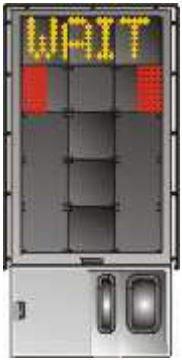 |
| 1.2.2 CAPTURE The yellow scrolling arrows indicate that the system is activated and in capture mode, searching for an approaching aircraft. It shall be checked that the correct aircraft type is displayed. The lead-in line shall be followed.
| 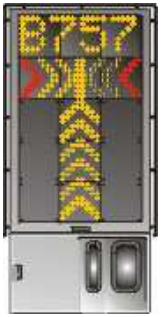 |
| 1.2.3 TRACKING On successful capture of the aircraft, the yellow scrolling arrows are replaced by the yellow centre line indicator (Closing Rate Bar). The flashing red arrow indicates the direction the aircraft should turn. The vertical yellow arrow shows position in relation to the centre line. This indicator gives the correct position and azimuth guidance.
| |
| 1.2.4 CLOSING RATE Display of digital countdown starts when the aircraft is 20 meters from stop position.
| 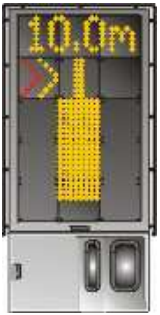 |
| 1.2.5 ALIGNED TO CENTRE The absence of any direction arrow indicates the aircraft is on the centre line.
| 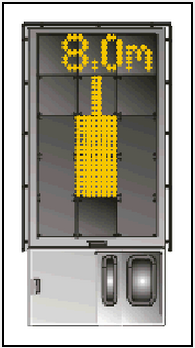 |
| 1.2.6 SLOW DOWN If the aircraft is approaching faster than the accepted speed, the system will show 'SLOW DOWN' as a warning to the pilot. | 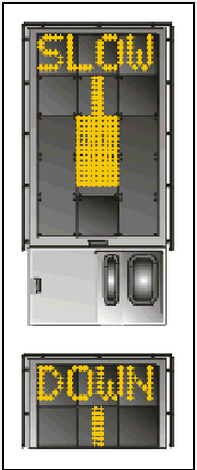 |
| 1.2.7 STOP-POSITION REACHED When the correct stop-position is reached, the display will show 'STOP' and red lights will be lit. | 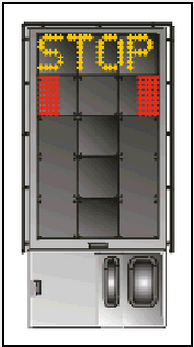 |
| 1.2.8 DOCKING COMPLETED When the aircraft has parked, 'OK' will be displayed. | 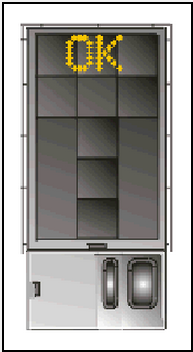 |
| 1.2.9 OVERSHOOT If the aircraft has overshot the stop-position, 'TOO FAR' will be displayed. | 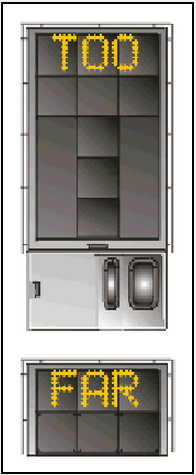 |
| 1.2.10 STOP SHORT If the aircraft is found standing still but has not reached the intended stop-position, the message 'STOP OK' will be shown after a while. | 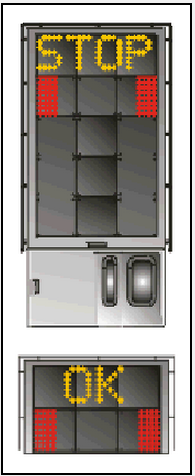 |
| 1.2.11 WAIT If some object is blocking the view toward the approaching aircraft or the detected aircraft is lost during docking close to STOP, the display will show 'WAIT'.
|  |
| 1.2.12 SLOW This display can be shown for two reasons:
| 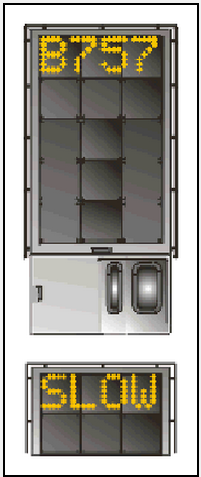 |
| 1.2.13 AIRCRAFT VERIFICATION FAILURE During entry into the stand, the aircraft geometry is being checked. If, for any reason, aircraft verification is not made 12 meters before the stop-position, the display will first show 'WAIT' and make a second verification check. If this fails, 'STOP' and 'ID FAIL' will be displayed. The text will be alternating on the upper two rows of the display.
|  |
| 1.2.14 GATE BLOCKED If an object is found blocking the view from the docking system to the planned stop position for the aircraft, the docking procedure will be halted with a 'WAIT' and 'GATE BLOC' message. The docking procedure will resume as soon as the blocking object has been removed.
|  |
| 1.2.15 VIEW BLOCKED If the view towards the approaching aircraft is hindered, for instance by dirt on the window, the docking system will report a view blocked condition, i.e. ‘VIEW BLOC’. Once the system is able to see the aircraft through the dirt, the message will be replaced by closing rate bar.
|  |
| 1.2.16 SBU-STOP Any unrecoverable error during the docking procedure will generate a SBU (Safety Back Up) condition. The display will show red stop-bar and 'STOP SBU' message.
| 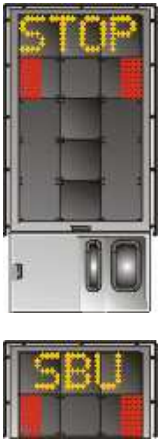 |
| 1.2.17 TOO FAST If the aircraft approaches with a speed higher than the docking system can handle, the message 'STOP' (with red squares) and 'TOO FAST' will be displayed. The docking system will be re-started or the docking procedure completed by manual guidance. |  |
| 1.2.18 EMERGENCY STOP Pilots should stop the aircraft immediately when 'STOP' is displayed. | 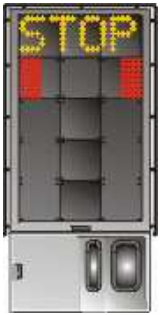 |
| 1.2.19 CHOCKS ON 'CHOC ON' will be displayed, when the ground staff has put the chocks in front of the nose wheel and pressed the "chocks on" button on the operator panel. | 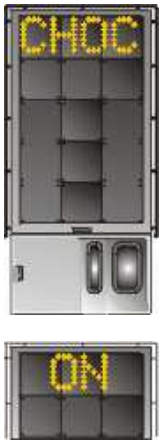 |
| 1.2.20 ERROR If a system error occurs, the message 'ERR' will be displayed. | 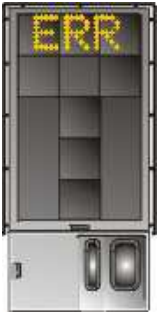 |
| 1.2.21 SYSTEM BREAKDOWN In case of a severe system failure, the display will go black except for the red stop indicator. A manual backup procedure will be used for docking guidance. | 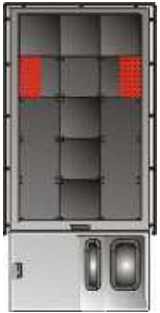 |
| 1.2.22 POWER FAILURE In case of a power failure, the display will be completely black. A manual backup procedure will be used for docking guidance. | 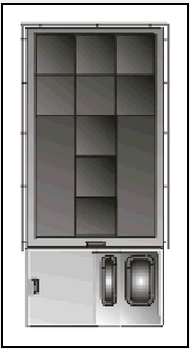 |
2 AIRPORT COLLABORATIVE DECISION MAKING (ACDM)
2.1 GENERAL
2.2 A-CDM PRE-DEPARTURE PROCEDURES
- A-CDM platform
- Turnaround Coordinator
- A-CDM platform at 30 minutes before TOBT
- Turnaround Coordinator
Note: Flight deck crew shall not contact ATC for start-up request earlier than TSAT -2 minutes.
2.3 OTBD A-CDM START-UP PROCEDURE
OTBD AD 2.24 CHARTS RELATED TO AN AERODROME
OTBD AD 2.25 VISUAL SEGMENT SURFACE (VSS) PENETRATION
VSS is penetrated for the following Approaches of THR RWY 33.
| PROCEDURE | OCA / OCH (FT) | VSS PENETRATION | |||||||||
|---|---|---|---|---|---|---|---|---|---|---|---|
| OBST Description | OBST ELEV (FT) | Penetration (FT) | OBST Location | ||||||||
| A | B | C | D | E | LAT | LONG | Description | ||||
| OTBD RNP RWY 33 (LNAV/VNAV) | 390 / 363 | Streetlight | 110 | 17.51 | 251407.46N | 0513425.71E | 0.36NM before THR RWY 33, left of approach centreline. | ||||
| Streetlight | 110 | 9.83 | 251405.42N | 0513426.80E | 0.40NM before THR RWY 33, left of approach centreline. | ||||||
| Streetlight | 109 | 1.96 | 251403.39N | 0513427.88E | 0.44NM before THR RWY 33, left of approach centreline. | ||||||
| OTBD RNP RWY 33 (LNAV) | 420 / 393 | Streetlight | 110 | 17.51 | 251407.46N | 0513425.71E | 0.36NM before THR RWY 33, left of approach centreline. | ||||
| Streetlight | 110 | 9.83 | 251405.42N | 0513426.80E | 0.40NM before THR RWY 33, left of approach centreline. | ||||||
| Streetlight | 109 | 1.96 | 251403.39N | 0513427.88E | 0.44NM before THR RWY 33, left of approach centreline. | ||||||
